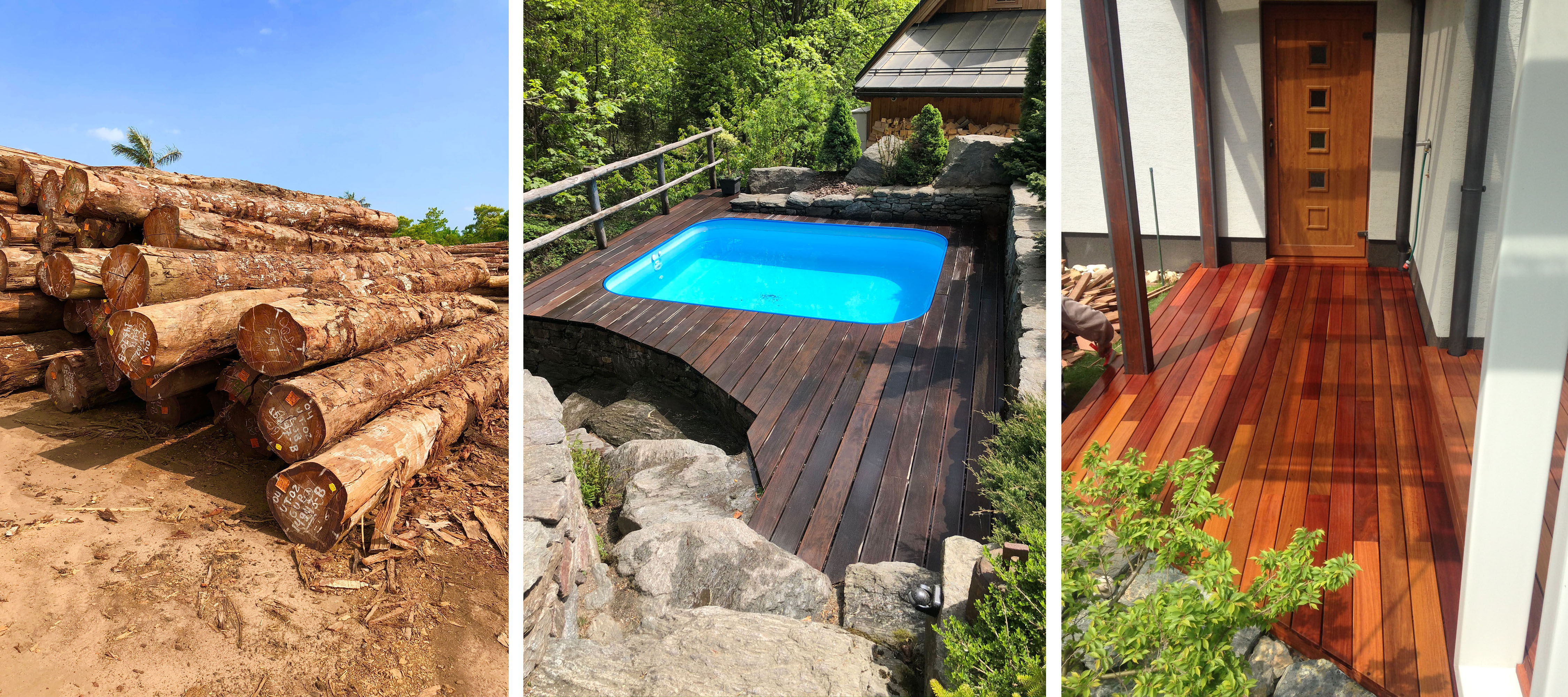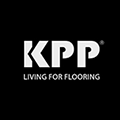
The terraces made of exotic woods from KPP have their identification number
KPP also offers flooring for outdoor living spaces.

If you decide on a terrace made of exotic woods from the offer of Kratochvíl parket profi (KPP), you can learn about the rainforest they come from. Controlled logging in South America does not allow the cutting down and exporting of a single tree without a "birth number" that enables strict sustainability control of logging. Given their long lifespan of up to thirty years, exotic woods therefore represent a more ecological option than the "softer" European types. The latter have a lifespan of about half to a third, so you will need to replace your terrace more often and consume more softwood.
Recently, terraces have become a welcome extension of the living space of apartments or houses into the outdoors. It is no wonder that the manufacturer and distributor of flooring coverings, Kratochvíl parket profi (KPP), offers a wide range of "flooring" for terraces. Exotic woods are mainly imported from South America, but they also offer Nordic, European thermally modified or impregnated woods, as well as composite WPC (Wood Polymer Composite) terraces.
Just like with interior flooring, there is no universal material suitable for all situations when it comes to terraces. “I would not recommend softwoods for pools due to splinters; exotic woods are ideal for barefoot walking. For mountainous areas like the Krkonoš and Jeseníky Mountains, or in southern Moravia, where temperatures, dryness, and humidity fluctuate extremely, I would also avoid conifers. Exotic wood is simply suitable for extremes because it is more stable, harder, and does not rot. It also depends on the orientation of the terrace, whether it faces north or receives southern sunlight,” outlines various situations Aleš Lorenc, sales specialist at KPP.



Exotic woods have their own self-defense
Exotic woods are known for their high hardness, mechanical resistance, and especially long lifespan. This is due to the fact that trees grow in moisture and heat. In such a demanding environment, however, molds and various pests also thrive, which the trees must withstand. Hence, they have developed a defense mechanism in the form of high wood density, which does not allow much moisture, mold, or fungi to penetrate. Their solid structure creates a barrier against these wood-destroying organisms. KPP also offers Ipe lapacho wood from the Caribbean region, one of the highest quality terrace woods. It is very heavy (approximately 1100 kg/m3 when dry) and dense. Its physical properties surpass any other commercially available wood. Additionally, KPP offers the very popular Garapa, Cumaru, Bangkirai, Teak, and newly Angelim Amargoso from exotic woods.
According to Aleš Lorenc from KPP, using exotic wood, considering its long lifespan, is a more ecological option than a terrace made of soft European wood, thanks to the aforementioned controlled logging system in South America. “Photographs of clearings where tropical rainforests once stood and are now just bare soil are unjustly attributed to loggers and processors of exotic wood. The opposite is true. This widespread deforestation occurs solely for the sake of livestock production and soybean cultivation. Trees from such deforested areas cannot be exported; they are burned on-site... In contrast, landowners engaged in logging have an interest in ensuring that their forest produces wood for generations. Hence, a controlled logging system was created, where every piece of forest has marked trees that can be cut down,” explains Aleš Lorenc from KPP. These trees are assigned a "birth number" without which no tree may leave the forest. Each tree receives its registration mark, an aluminum tag that is nailed to the trunk, allowing officials to check it on its way out of the forest. At the sawmill, the trunk is processed and again, each board is tagged to indicate from which tree it came. Containers with the wood undergo another inspection at the port, which can only be left by a container with the appropriate stamp. This is also why importers can verify and request a certificate indicating from which part of the forest the tree, or terrace board, comes.

Northern conifers are second in terms of lifespan
The second in terms of durability and resistance are northern woods. Due to the low northern temperatures, these woods grow more slowly, which results in greater fiber density and thus hardness and resistance. Although its lifespan cannot be compared to that of exotic woods, with Siberian larch, it is around 10-12 years compared to 25-30 years for exotic woods; it is still much better than wood from local forests.
European woods need to be thermally modified or impregnated
As for "ordinary" European woods, they can also be used for terraces, but only after necessary mechanical thermal modification, known as thermification, or after impregnation, which extends their longevity. Given the embargoes on the import of Siberian larch, it is expected that such modified woods will replace northern conifers.
Thermally modified wood is dried at 5-7% moisture content, without chemical additives, and subsequently processed at temperatures of about 160 - 215°C. This process kills the cells of the wood. After a process lasting 40 to 60 hours, the properties of the wood are permanently changed. The cells no longer function, meaning they do not absorb moisture. The wood then has increased resistance to rot and weather conditions, has a very long lifespan, does not form knots, has minimal swelling, and does not dry out, thus improving dimensional stability. After thermal modification, it has a luxurious brown surface that impresses almost everyone. However, thermal treatment reduces wood density, which results in a loss of hardness and therefore lower load-bearing capacity. Typical representatives of thermally modified terraces are northern pines or European ashes.
In contrast, during the pressure impregnation process, special agents are injected into the boards, which reliably ensure long-term protection of the boards. Effective substances against rot, wood-destroying insects, and fungi are also infused into the wood. You can choose between two types of pressure impregnation, which differ visually in the final coloring of the boards.




WPC is the choice for long lifespan and minimal maintenance
The last type represented in KPP's offer is WPC terraces, which are composite materials made from a mixture of wood and plastics. WPC is a choice for long lifespan and minimal maintenance. For an additional fee, a brushed wood appearance can be achieved, mimicking a wooden terrace almost indistinguishably. These composite materials are made from a mixture of wood flour and HDPE or PVC. Again, proper choice is important; for example, the structure of the board itself has a significant influence, where solid boards have a significantly higher lifespan as condensation does not form inside the board like it does with hollow profiles.
The composite terraces offered by KPP include a blend of high-density polyethylene (HDPE). Because of the high fiber content (50%), the product not only has great resistance to changing weather conditions, moisture, insects, mold, corrosion, rot, and cracking, but is also easy to process. They do not require surface treatment, their installation is easy, and they are low-maintenance. “For example, the terrace boards WPC KPP PREMIUM, SOLID AND WOODSOLID are pleasant to walk on barefoot, are non-slip, and do not splinter or produce any chips. Each board has fine grooves on one side and a rough texture on the other. Due to their long lifespan and minimal maintenance costs, the WPC KPP terrace system is rated as a very economical terrace system and an ecological product,” adds Aleš Lorenc from KPP.
LIFESPAN OF WOODS
- Class 1: more than 25 years: Burma Teak, Cumaru, Ipe, Tatajuba
- Class 1-2: more than 20 years: Massaranduba, Merbau, Garapa, Iroko
- Class 2: 15 to 25 years: Cedar, Java Teak, Bangkirai, Garapa, Kempas, Thermo Ash, WPC - wood-plastic terraces
- Class 3: moderately durable - 10 to 15 years: Douglas Fir, Sapeli, Siberian Larch, Keruing, Thermo Pine
- Class 4: weakly durable - 5 to 10 years: Pine, Spruce, Fir, Larch
You can view the terrace offer at KPP showrooms in Prague and Brno, or you can take advantage of their virtual tour.
http://podlahyonline.cz
www.kpp.cz












